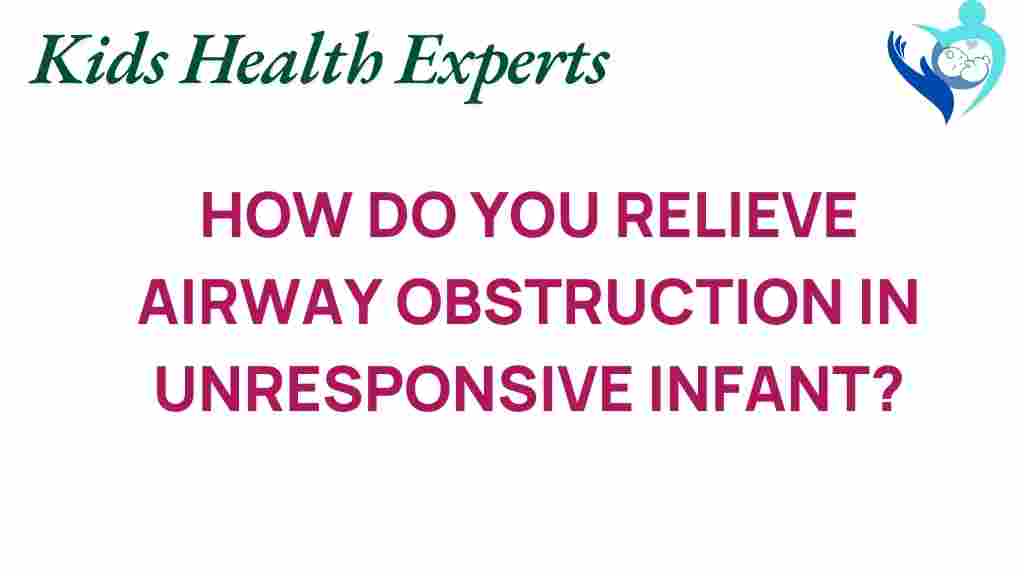Unlocking the Secrets: How to Relieve Airway Obstruction in Unresponsive Infants
Airway obstruction in infants can be a terrifying experience for any caregiver. When an infant is unresponsive due to choking or a blocked airway, knowing how to respond quickly and effectively can save a life. In this article, we will explore essential techniques for relieving airway obstruction, focusing on emergency response, first aid, and infant CPR. Understanding these methods is crucial for pediatric health and safety, especially for parents, babysitters, and anyone caring for infants.
Understanding Airway Obstruction
Airway obstruction occurs when an object blocks the airway, preventing air from reaching the lungs. In infants, this is often caused by:
- Food items (such as small pieces of fruit or nuts)
- Small toys or objects
- Vomitus
- Swelling of the airway due to allergies or infections
Recognizing the signs of airway obstruction is crucial. Common indicators include:
- Inability to cry or make sounds
- Coughing weakly or not at all
- Blue or pale skin, particularly around the lips and face
- Unresponsive or lethargic behavior
Emergency Response to Choking in Infants
When faced with airway obstruction, every second counts. Here’s a step-by-step guide on how to respond effectively:
1. Assess the Situation
Before taking action, carefully assess the infant’s condition:
- Is the infant conscious or unresponsive?
- Is the infant able to cough or breathe?
If the infant is unresponsive and not breathing, immediate action is required.
2. Call for Help
If you’re alone, call emergency services immediately. If someone else is present, have them call while you assist the infant.
3. Perform Back Blows
For an infant who is conscious but choking:
- Position the infant face down on your forearm, supporting the head.
- Use the heel of your hand to deliver five firm back blows between the infant’s shoulder blades.
- Check if the object has been dislodged after each blow.
4. Administer Chest Thrusts
If back blows do not relieve the obstruction:
- Turn the infant face up while still supporting the head.
- With two fingers, perform five chest thrusts just below the nipple line.
- Check if the airway is clear after each thrust.
5. Continue Until Help Arrives
If the infant becomes unresponsive:
- Immediately begin infant CPR.
- Perform 30 chest compressions followed by 2 rescue breaths.
- Continue this cycle until emergency professionals arrive or the infant begins to breathe on their own.
Infant CPR: A Lifesaving Technique
Infant CPR is a critical skill in emergency situations. Here’s how to perform it:
1. Positioning
Place the infant on a firm, flat surface. Ensure the airway is open by tilting the head back slightly.
2. Chest Compressions
Using two fingers, push down about 1.5 inches deep at a rate of 100-120 compressions per minute. Allow the chest to fully rise between compressions.
3. Rescue Breaths
After 30 compressions, give 2 gentle rescue breaths:
- Seal your lips over the infant’s mouth and nose.
- Give a breath lasting about 1 second, watching for the chest to rise.
- Repeat with a second breath.
Troubleshooting Tips for Infant Care
Here are some troubleshooting tips to keep in mind during health emergencies involving airway obstruction:
- Stay calm: Your calm demeanor will help you think clearly and reassure the infant.
- Do not stick your fingers in the infant’s mouth: This may push the object further down the throat.
- If the infant becomes responsive, encourage them to cough to help dislodge the object.
- After any choking incident, it’s essential to seek medical attention to ensure there are no residual issues.
Preventing Airway Obstruction
Prevention is always better than cure. Here are steps to reduce the risk of airway obstruction in infants:
- Supervise infants during meal times and avoid giving them hard, round foods.
- Keep small objects out of reach and ensure toys are age-appropriate.
- Educate all caregivers about the signs of choking and proper first aid techniques.
For more information on pediatric health and safety, visit the American Academy of Pediatrics.
Conclusion
Knowing how to relieve airway obstruction in unresponsive infants is a vital skill for anyone involved in infant care. By being prepared and familiar with emergency response techniques, you can act swiftly and effectively in a crisis. Remember, practice makes perfect; consider enrolling in an infant CPR and first aid class to enhance your skills. With the right knowledge and preparedness, you can help safeguard the health and well-being of the infants in your care.
For further learning, check out our comprehensive guide on first aid techniques for parents.
This article is in the category Care and created by KidsHealthExperts Team
